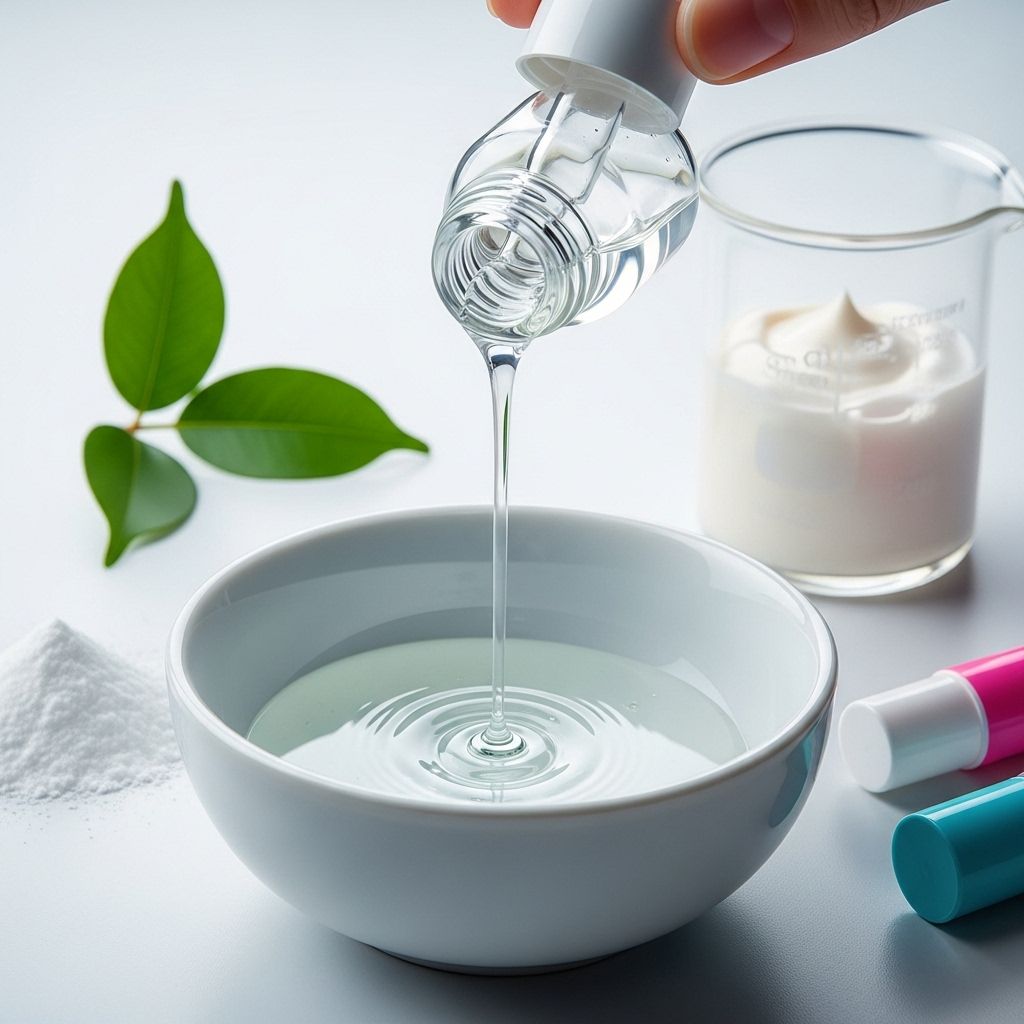Poloxamer 188: Properties, Uses, and Safety in Cosmetics
Discover the science, benefits, and safety of Poloxamer 188—a versatile cosmetic and pharmaceutical ingredient.

Poloxamer 188 is a nonionic, synthetic block copolymer surfactant and emulsifier widely used in cosmetics, pharmaceuticals, and personal care products for its ability to stabilize, cleanse, and improve the feel of formulations. This versatile ingredient offers multiple functional benefits due to its unique amphiphilic structure, which supports solubilization, dispersion, and foam boosting in various applications.
Table of Contents
- Poloxamer 188 Overview
- Origin and Chemistry
- Key Functions and Applications in Cosmetics
- Broader Industrial and Pharmaceutical Uses
- Formulation Properties and Technical Details
- Safety Assessment
- Regulatory Status
- Frequently Asked Questions (FAQs)
Poloxamer 188 Overview
Poloxamer 188, also known by names such as Pluronic F68 and Vepoloxamer, is a synthetic block copolymer consisting of hydrophobic and hydrophilic segments. It typically appears as a white to off-white, free-flowing powder or a clear, colorless gel or paste, depending on its formulation and concentration. In the cosmetics industry, it is recognized for its functions as a surfactant, cleansing agent, emulsifier, and solubilizer.
| Attribute | Detail |
|---|---|
| INCI Name | Poloxamer 188 |
| Chemical Name | α-(hydroxy-ω-hydroxypoly(oxyethylene)poly(oxypropylene)poly(oxyethylene)) block copolymer |
| CAS Number | 9003-11-6 |
| EINECS/ELINCS | 232-089-9 |
| Chemical Formula | HO(C2H4O)a(C3H6O)b(C2H4O)aH (block copolymer, block sizes vary) |
Origin and Chemistry
Poloxamer 188 is synthesized through a controlled polymerization process involving two primary monomers: propylene oxide and ethylene oxide. The process usually begins with the polymerization of propylene oxide to form a central hydrophobic chain (polyoxypropylene core), followed by the addition of hydrophilic polyoxyethylene chains on both ends. This triblock copolymer structure imparts both water-loving (hydrophilic) and oil-loving (hydrophobic) properties, granting unique amphiphilic behavior.
- Amphiphilic nature—The presence of both hydrophobic and hydrophilic segments allows Poloxamer 188 to interact with oils and water, essential for emulsifying and solubilizing ingredients in cosmetic and pharmaceutical formulations.
- Physical forms—Poloxamer 188 may appear as a paste, liquid, or solid, depending on its purity, hydration, and manufacturing process.
- Other names—Pluronic F68, Vepoloxamer, and a-Hydro-o-hydroxypoly(oxyethylene)poly(oxypropylene) poly-(oxyethylene) block copolymer. The precise ratios of hydrophilic to hydrophobic blocks define its unique properties among related poloxamers.
Key Functions and Applications in Cosmetics
Poloxamer 188 is a multifunctional ingredient in the cosmetics industry, imparting a range of desirable properties that enhance product performance and user experience. Its unique structure enables it to serve several key functions:
- Cleansing agent: Efficiently removes oil, dirt, and debris from the skin and hair by allowing water to dissolve and wash away impurities.
- Foam booster and stabilizer: Enhances the lathering properties of cosmetic cleansers, ensuring a rich, stable foam during use.
- Emulsifier: Stabilizes blends of oil and water, preventing phase separation and ensuring uniform product texture.
- Solubilizer: Facilitates the incorporation of poorly water-soluble ingredients into water-based formulations.
- Humectant and lubricant: Attracts moisture to the skin and improves the spreadability of creams and gels, promoting a smooth, non-greasy finish.
- Preservative booster: Improves the shelf life and stability of formulations by providing mild antimicrobial action and supporting even distribution of preservatives.
Poloxamer 188 is commonly found in:
- Facial and eye cleansers
- Shampoos and conditioners
- Foaming gels and body washes
- Eye makeup removers
- Serums, lotions, and creams—including moisturizers and anti-aging care
Broader Industrial and Pharmaceutical Uses
Beyond cosmetics, Poloxamer 188 finds wide-ranging uses across healthcare, food, and industrial sectors due to its mildness, safety, and efficacy in enhancing product stability and function:
- Pharmaceutical drug delivery:
- Improves dispersion and stability in oral liquid medications and suspensions
- Forms hydrogels for controlled drug release, particularly in wound care applications
- Component in nasal sprays and intravenous formulations, enhancing solubility and absorption
- Wound care: Used in gels and dressings to maintain a moist environment and improve absorption of therapeutic agents.
- Veterinary medicine: Facilitates injectable delivery and improves the bioavailability of active drugs in animals.
- Food industry: Occasionally employed to enhance the stability and mouthfeel of emulsions and suspensions.
Formulation Properties and Technical Details
Poloxamer 188 exhibits several critical properties that make it valuable to formulators working on cosmetics, personal care, and pharmaceutical products:
- Nonionic surfactant: Exhibits low reactivity and high compatibility with a wide range of cosmetic and pharmaceutical actives.
- Thermal stability: Remains stable over a broad temperature range; can exhibit thermoreversible gelation, useful for temperature-sensitive formulations.
- Biodegradability: Breaks down naturally, supporting more sustainable formulation practices.
- High biocompatibility: Non-toxic, rarely irritates the skin, and safe for repeated external application.
- pH Stability: Remains effective across a wide pH range (typically pH 3–10).
| Property | Description |
|---|---|
| Appearance | White to off-white powder, granules, or viscous liquid |
| Odor | Mild, characteristic |
| Solubility | Highly soluble in water (up to 80% water-soluble components) |
| Amphiphilicity | Contains both hydrophilic (water-attracting) and hydrophobic (oil-attracting) blocks |
| Surface Tension Reduction | Efficiently reduces surface tension, aiding in emulsification and cleansing |
Safety Assessment
Poloxamer 188 is considered safe and well-tolerated for routine use in personal care products, topical medications, and various drug delivery formulations. Its safety has been extensively evaluated through both laboratory research and practical use in commercial products:
- Low toxicity: Lethal dose (LD50) values in animal studies are very high (5–34.6 g/kg), indicating low acute toxicity.
- Minimal irritation: Nonionic nature prevents significant irritation or sensitization to skin and eyes for most users.
- Biodegradation and excretion: Rapidly excreted and biodegraded in biological systems; minor accumulation reported only at very high doses.
- Impurities: Commercial grades may contain trace levels of aldehydes, formic and acetic acids, 1,4-dioxane, and unreacted monomers. Regulatory standards address these impurities to ensure safe consumer use.
Extensive safety reviews have found no evidence of carcinogenic, mutagenic, or reproductive toxicity at practical concentrations. However, rare cases of allergic reaction or irritation may occur, particularly with prolonged or large-scale parenteral (injected) use, rather than topical cosmetic application.
Regulatory Status
- Approved for use in cosmetic and personal care products in the United States, European Union, and other major jurisdictions.
- Included in the International Nomenclature of Cosmetic Ingredients (INCI) as Poloxamer 188.
- National Formulary (NF) grade available, establishing purity standards for pharmaceutical and medicinal applications.
- Typical use levels in cosmetics range from 0.005% to 20% depending on product type and formulation needs.
Frequently Asked Questions (FAQs)
Q: What is Poloxamer 188, and why is it used in cosmetics?
A: Poloxamer 188 is a synthetic surfactant and emulsifier valued for its gentle, non-irritating cleansing, foaming, and emulsifying properties. It enables formulators to blend oil, water, and active ingredients, resulting in stable, user-friendly products like cleansers, serums, and gels.
Q: Is Poloxamer 188 safe for skin and eyes?
A: Yes. Comprehensive safety assessments show that Poloxamer 188 is non-toxic and generally non-irritating for skin and eyes at concentrations used in cosmetics. It has a long history of safe use in topical and even ophthalmic (eye) formulations. However, people with extremely sensitive skin should consult their healthcare or dermatology provider if irritation occurs.
Q: In what types of personal care products is Poloxamer 188 most often found?
A: It is widely used in foaming cleansers, micellar water, makeup removers, shampoos, conditioners, facial and body washes, and even some anti-aging serums. Its foam-boosting and mild cleansing properties are especially valued in face and eye products.
Q: What makes Poloxamer 188 different from other surfactants?
A: Its unique triblock structure gives it excellent water solubility and the ability to create stable foams and emulsions with minimal irritation. Compared to harsher surfactants, Poloxamer 188 is much milder on the skin, making it suitable for sensitive formulations.
Q: Does Poloxamer 188 have any environmental or health concerns?
A: Poloxamer 188 is considered biodegradable and does not persist in the environment. Trace impurities are regulated and monitored to ensure consumer safety. It poses low health and environmental risks when used as intended.
Q: Is Poloxamer 188 used in medicinal or pharmaceutical products?
A: Yes. Its safety and biocompatibility allow Poloxamer 188 to be included in oral, topical, ophthalmic, nasal, and injectable drug formulations for improved solubility, stability, and drug delivery efficacy.
Q: How can I tell if my cosmetic product contains Poloxamer 188?
A: Look for “Poloxamer 188” in the ingredient list—sometimes listed under alternate names like Pluronic F68. It is typically present in products that emphasize mild foaming and gentle cleansing, such as micellar waters and makeup removers.
Summary Table: Poloxamer 188 in Cosmetic and Pharmaceutical Formulations
| Function | Benefits | Common Product Types |
|---|---|---|
| Cleansing Agent | Removes oils, dirt, and impurities gently | Facial cleansers, shampoos, body washes |
| Emulsifier | Stabilizes oil-and-water mixtures | Creams, lotions, makeup removers |
| Foam Booster | Produces stable, rich foam | Facial foams, shaving gels, micellar water |
| Solubilizer | Helps dissolve poorly soluble actives | Serums, gels, drug formulations |
| Drug Delivery Aid | Enhances stability and absorption | Wound care gels, injectable drugs |
In summary, Poloxamer 188 stands out as a well-established, gentle, and effective ingredient that improves cleansing performance, enhances product stability, and delivers a smooth, non-greasy feel for a wide range of cosmetic, personal care, and pharmaceutical products.
Read full bio of medha deb











